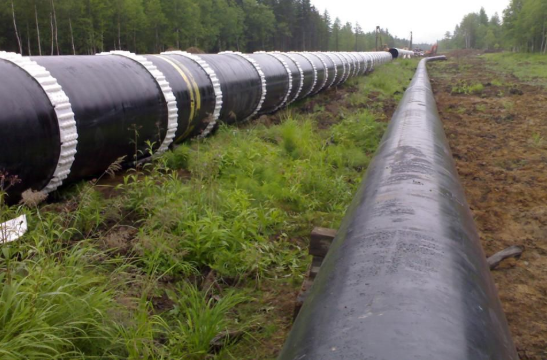
Construction of the gas pipeline on the ground. Transportation of energy carriers.
Over the last 25 years trade with Canada and Mexico has quadrupled, almost reaching $1.3 trillion and supporting 14 million American jobs through our trading partners.The U.S. energy benefits provided through this agreement makes even more vital that we continue this trade partnership through the U.S.-Mexico-Canada-Agreement (USMCA).
Recently the International Trade Commission’s review of the new USMCA finds that the agreement will improve the U.S. economy broadly, raising GDP by $68 billion and employment by 176,000 jobs. This will not surprise either economists or historians, who have long noted the benefits of trade. But a closer look at the impact of North American trade for America’s energy sector is also instructive. The economic benefits of North American trade for energy underscore the critical importance of passing this agreement and why withdrawing from the North American Free Trade Agreement (NAFTA) would be perilous.
The release of the International Trade Commission’s review of the new U.S-Mexico-Canada Trade Agreement (USMCA) finds that the agreement will improve the U.S. economy broadly, raising GDP by $68 billion and employment by 176,000 jobs. This will not surprise either economists or historians, who have long noted the benefits of trade. But a closer look at the impact of free trade on one industry is also informative.
The debate about NAFTA typically revolves around automobiles and farm goods, but the benefits to the United States from increased energy trade is of great value. The bulk of this stems from American natural gas exports to Mexico, which grew from 50 billion cubic feet in 1994, when NAFTA was enacted, to 1,700 Bcf in 2018. The U.S. received a total of $49 billion over that period (2015$), rising to $5.5 billion in 2018.
Aside from the revenue for the oil industry and the reduced U.S. trade deficit, the indirect effects go much further. Aside from the billions of dollars in taxes paid on that revenue, an amount hard to determine with precision, there are the employment effects and the environmental benefits, both of which tend to be ignored but are significant.
Given that 210,000 workers are employed by the petroleum industry directly, and Mexican gas exports in 2018 represent (by energy content) 3% of operations, the implication is that there are roughly 6,000 workers whose jobs are directly dependent on natural gas exports to Mexico. Typical employment multipliers would mean 42,000 jobs result from these exports. And petroleum industry jobs are amongst the best paid in America, with salaries averaging $100,000 in 2017.
Additionally, pipeline construction translates into a significant number of jobs, albeit most of them short-term. The recent $1.5 billion Valley Crossing Pipeline created 3,300 construction jobs and about 140 long-term jobs. That pipeline represents about one-third of our export capacity, so the earlier projects would account for roughly double those numbers.
It’s also vital to realize that natural gas sent to Mexico is used in place of coal and residual fuel oil in power generation and heavy industry, with significant environmental benefits for both countries. Natural gas is much cleaner than both of those. Coal emits from 0.67-6.43 bls/MMBtu of sulfur dioxide and 1.82-34.71 lbs/TBtu of mercury, while residual fuel oil emits 0.3-2.65 lbs/MMBtu of sulfur dioxide and 0.48 lbs/TBtu of mercury, depending on the quality. Natural gas emits no sulfur dioxide and only trace amounts of mercury.
So, even assuming that only residual fuel oil is displaced rather than coal, the result is between half a million and four million pounds of SO2, and 700 pounds of mercury. The CO2 savings are about 42 million tons per year. While it is impossible to estimate how much SO2 and mercury finds its way into the U.S. environment, we undoubtedly benefit from these reductions.
Finally, the money from the gas sales flows into the upstream industry and permits additional drilling, much of it for oil (the average oil well in the Permian produces about half as much natural gas as oil), which has the advantage of lowering U.S. oil imports and, to some degree, moderating global oil prices. The amounts are not massive, but in a tight oil market, every bit helps.
Additionally, Canada is America’s leading source for crude oil imports and number one market for American crude oil exports. An OPEC competitor or a country like Russia or Saudi Arabia cannot take a claim to this fact. America’s energy security is therefore supported through North American energy market integration.
Overall, the impact of NAFTA on the U.S. energy industry and economy, especially when considering the improved trade balance, jobs created, potential for energy security, are quite significant. These benefits should not be disregarded in any future USMCA deliberations by Congress.
The U.S.-Mexico-Canada Agreement is critical for many sectors of our economy but would further solidify the U.S’s energy leadership. Strengthening America’s oil and natural gas exports to Canada and Mexico will bolster further economic activity with our strongest trading partners, and enhance economic activity here at home.
Overall, the impact of NAFTA on the U.S. energy industry and economy, especially when considering the improved trade balance, jobs created, and reduced emissions in a neighboring country, are quite significant and should not be disregarded in any future negotiations.